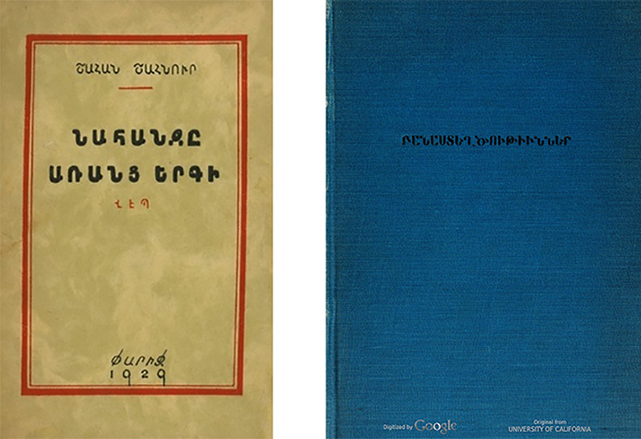Tag: BL Middle East
Armenian
The Languages of Berkeley: An Online Exhibition

At the request of the Librarian for the Armenian Studies, Liladhar Pendse, we are posting this entry on April 22nd in the memory of the victims of Armenian Genocide. The 24th of April is Armenian Genocide Remembrance Day. The resilience of the Armenian nation, language and culture exemplify a human desire to overcome destruction and create literary monuments.
Armenian scholar and official at the court of King Vramshapuh, Mesrop Mashtots (Մեսրոպ Մաշտոց) invented the Armenian alphabet in 405 CE. Today, Western Armenian is one of the two standardized forms of Modern Armenian, the other being Eastern Armenian. Until the early 20th century, various Western Armenian dialects were spoken in the Ottoman Empire, especially in the eastern regions of the empire historically populated by Armenians and which are known as Western Armenia. Western Armenian language is also spoken in France and in the diaspora of Armenians in the United States. On the other hand, Eastern Armenian is spoken in Armenia, Artsakh, Republic of Georgia, and in the Armenian community in Iran. The two Armenian standards together form a pluricentric language. Nevertheless, only Western Armenian is considered one of the endangered languages by the UNESCO.
In the late 1980s, a group of Bay Area Armenian-American visionaries decided to introduce the concept of Armenian Studies at one of the most renowned universities in the world — the University of California, Berkeley. Within a few years, under the leadership of the UC Berkeley Armenian Alumni, and thanks to the remarkable mobilization of the community and generosity of major donors, the William Saroyan Visiting Professorship in Modern Armenian Studies was established. Later the Krouzian Endowment, established in 1996, would provide this position with significant additional support. In the fall of 1998, the William Saroyan Visiting Professorship became a full-time position.
Professor Stephan Astourian was appointed Executive Director of the Armenian Studies Program and Assistant Adjunct Professor of History in July 2002. The William Saroyan position was no longer dependent on temporary appointments. Professor Astourian began to build the foundation of a full-fledged academic program focused on contemporary Armenian history, politics, language, and culture. The program now offers Armenian history Armenian that is further enriched by visiting scholars, academic conferences, symposia, and public speaking engagements organized or delivered by Professors Astourian and Douzjian.
Shahan Shahnur’s Retreat Without Song was serialized in the Paris daily Haraj (Onward) before it was published as a novel in 1929. Set in Paris, the novel traces a tempestuous love story that provokes an identity crisis in the main character. While the interethnic romance between an Armenian man and a French woman drives the novel’s plot, its setting and characterization foreground the challenges Armenians faced after their exile from Istanbul, in the aftermath of the genocide. Upon publication, the novel enjoyed immediate success among readers; however, conservative critics, appalled by its violation of cultural taboos, labeled it pornographic. Today, precisely for its provocative treatment of religious values, romance, and diasporic life, Retreat Without Song rightfully occupies a place among the foundational texts of modern Western Armenian literature.
Hovhannes Tumanyan’s artful Eastern Armenian verse, unanimously loved by readers for over a century, presents cultural wisdom and a witty, critical perspective on socio-political dynamics. This collection includes two narrative poems that inspired operas: the tragic love story depicted in Anush served as the libretto for Armen Tigranyan’s homonymous opera whereas The Capture of Fort Temuk, a historical tale of political intrigue, was the basis for Alexander Spendiaryan’s Almast. Also notable in this collection, David of Sasun is based on the third cycle of the Armenian epic Daredevils of Sasun. A remarkable piece of literature, this epic circulated orally for almost a millennium until its first transcription in 1873, which in turn paved the way for studies and transcriptions of additional variants. Tumanyan’s verse adaptation of this epic, first published in 1904 and still widely read, bespeaks the poet’s mastery of folkloric style.
Contribution by Stephan Astourian & Myrna Douzjian
Faculty, Armenian Studies Program
Liladhar Pendse, Librarian for Armenian Studies, Doe Library
Title: Nahanjě aṛantsʻ ergi
Title in English: Retreat Without Song
Author: Shahnur, Shahan, 1903-1974
Imprint: Serialized for the daily newspaper Haraj =Haratch (Paris: Imp. Araxes, 1925-?).
Edition: Unknown
Language: Eastern Armenian
Language Family: Indo-European, Armenian
Source: Digital Library of Armenian Literature
URL: http://www.digilib.am/book/882/Երկեր%20թիւ
Print editions in Library:
- Sessiz ricat : resimli Ermeni tarihi = Nahanjě aṛantsʻ ergi = Silent Retreat = Retreat Without Song / Şahan Şahnur ; Ermeniceden çevirenler Maral Aktokmakyan, Artun Gebenlioğlu. Beyoğlu, İstanbul : Aras, 2016.
- Retreat Without Song / Shahan Shahnour ; translated from the Armenian and edited by Mischa Kudian. London : Mashtots Press, 1982.
Title: Banasteghtsutʻiwnner
Title in English: Selected Poems
Author: Tʻumanyan, Hovhannes, 1869-1923
Imprint: Kostandnupolis : Tpagrutʻiwn K. Kʻēshishean Ordi, 1922.
Edition: 1st edition
Language: Eastern Armenian
Language Family: Indo-European, Armenian
Source: HathiTrust Digital Library (UCLA)
URL: https://hdl.handle.net/2027/uc1.l0081024747
The Languages of Berkeley is a dynamic online sequential exhibition celebrating the diversity of languages that have advanced research, teaching and learning at the University of California, Berkeley. It is made possible with support from the UC Berkeley Library and is co-sponsored by the Berkeley Language Center (BLC).
Follow The Languages of Berkeley!
Subscribe by email
Contact/Feedback
ucblib.link/languages
![The Languages of Berkeley [fan]](https://update.lib.berkeley.edu/wp-content/uploads/2019/02/fan_languages-450px.jpg)